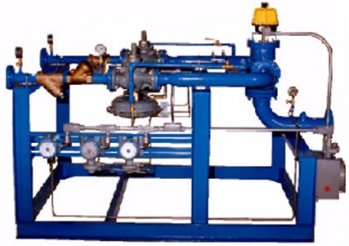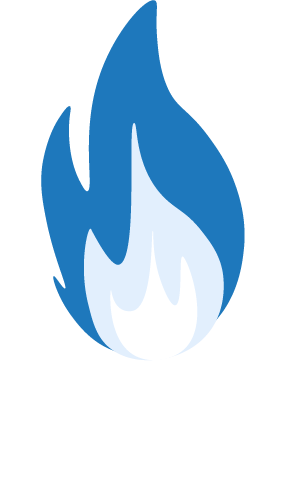Ensuring production continuity in industry is essential. In every industry, efforts are made to create alternative energy sources in case of delivery problems from the main source. Therefore, for industries that use natural gas, an alternative gas source can be considered to ensure production continuity. Liquid petroleum gas (LPG) is an alternative to natural gas. The use of modern LPG mixers allows for the proper selection of the gas and air mixture depending on whether the system contains natural gas or LPG. This universal solution ensures gas supply continuity in case of, for example, a drop in natural gas pressure or a complete cut-off of its supply.
Cost savings in industry are very important, but this cannot be at the expense of production quality or efficiency. The use of liquefied gas in industry significantly reduces costs, and with high-quality components used in gas installations, gas consumption can also be reduced. Properly selected LPG mixers that meet the highest standards provide lower gas consumption without compromising the performance of the entire installation. This means that investing in a professional installation can quickly pay off.

How LPG Mixers Work
The gaseous phase of LPG produced in the vaporizer is not directly interchangeable with natural gas. LPG gas/air mixers produce a gas mixture with similar properties. This allows users to switch the installation back and forth between natural gas supply from the distribution network and the reserve system powered by LPG without the need to change burner settings, boilers, etc. The simplest mixers are mixing devices based on a Venturi nozzle. In devices with higher performance and designed for high-pressure installations, AES patented mixers with a regulating piston are used.
History of LPG Mixers
LPG gas mixers with a regulating piston were allowed for use with US and international patents in 1987 and 1992. Since then, they have been produced by AES with a certain number of improvements to their control components, but without significant changes to the design concept. AES installations around the world include gas demand balancing systems, reserve systems for industrial users, reserve systems for state and defense installations, main fuel sources for regions without natural gas resources or preparing for connection to natural gas, and installations for power plants, glass factories, brickworks, etc.
Mixers with a regulating piston can be used with AES LPG vaporizers or with already operating vaporizers from other manufacturers. Installing them with vaporizers allows for full integration with a versatile, computerized control system for device operation. LPG mixers can be used, for example, in reserve installations, when there are drops in natural gas supplies, to cover peaks, enrich the calorific value of natural gas with propane, etc.
Gas phase mixing systems for LPG with air. Piston-controlled mixers.
Compact design;
Low maintenance and operating costs;
High reliability;
Small dimensions, high efficiency;
American and international patents;
Applicable for low and high-pressure installations;
For backup systems or systems that equalize peak demand values;
Capacity from 5.86 to 117.2 MW;
Optionally:
- Complete integrated vaporization system;
- Optional automatic Wobbe index control (oxygen content, calorific value, or specific gravity);
- Optional flow control system for equalizing systems;
- Optional remote control systems. LPG mixers: standard and optional properties. Standard properties of LPG mixers:
- Flange outlet for the LPG/air mixture;
- Inlet fittings for LPG gas phase and compressed air – both flanged or threaded;
- Electronic pressure relays for gas phase LPG, compressed air, gas mixture;
- Differential relay for pressure difference between gas phase LPG and air;
- Can be used outdoors or indoors;
- Produced in accordance with current technical knowledge;
- Pressure relief valve for safety from UL list;
- Electromagnetic valve (at the outlet of the gas phase) from UL list;
- The whole device has FM approval;
- Factory-mounted, painted, and tested.
Options:
- Control panel on request;
- Integration system on request (connection to the vaporizer);
- Common packaging with the vaporizer;
- Platform and regular pads for installation with the vaporizer;
- Flow meter with calculator;
- Calorific value and specific gravity meters;
- Automatic correction of gas mixture properties (calorific value, Wobbe number, specific gravity);
- Gas mixture temperature relay;
- Supply gas phase LPG temperature relay;
- Compressed air temperature relay;
- Explosion-proof relays and control system.
Application of LPG mixers
LPG gas mixers with piston control were approved for use with American and international patents in 1987 and 1992. Since then, they have been produced by AES with some improvements to their control components but without significant changes to the design concept. AES installations worldwide include gas demand equalization systems, backup installations for industrial users, backup systems for state and defense installations, primary fuel sources for areas without natural gas resources or areas preparing to connect to natural gas, and installations for power plants, glass factories, brickworks, etc. Piston-controlled mixers can be used with AES LPG vaporizers or with existing vaporizers from other manufacturers. Installing them with AES vaporizers allows for full integration with a versatile, computerized control system for device operation.
How do AES LPG/air mixers work?
Standard high-performance LPG and air gas phase mixers for high pressures were very complicated devices that were difficult to set up and required maintenance. In contrast, AES piston-controlled mixers are simple and reliable, with only two moving parts – a piston and a valve – which ensures a long lifespan and low operating costs. The mixing process is based on the flow of the LPG gas phase and compressed air through the mixer and their combination at the outlet. The mixer’s piston is moved by the pressure difference between the gas phase LPG and the air, and the piston’s position controls the air’s flow rate. In turn, the air flow rate regulates the mixture’s proportions and thus its calorific value and Wobbe index. The mixer is equipped with electronic pressure relays that control the operation of the piston and valve and ensure safe operation. The mixer’s compact design and high efficiency make it an attractive solution for various gas supply systems.
Automatic adjustment of gas mixture properties with lpg mixers
All patented mixers with a regulating piston (from POM-30 to POM-80) can be equipped with this option. The regulator consists of an electrical setting device mounted on the POM valve and a dedicated PID controller. The PID controller receives a 4-20 mA signal from the GraviBlendTM-3 densimeter and compares it to the set value corresponding to the desired mixture. If deviations are detected, the setting device rotates the piston position in the POM valve, effectively correcting the mixture properties until the customer’s requirements are met. If we use the GraviBlend model with the “ACUCON” option, the PID controller’s operation is integrated with the GraviBlendTM-3 microprocessor controller.
-3 – Specific gravity meter
The GraviBlendTM-3 densimeter measures the specific gravity of the LPG/air mixture. The output signal is an indicator of the generated gas. Maintaining a constant value of the specific gravity of the mixture is important where changes in gas enthalpy can affect burner or furnace performance, and where changes in thermal efficiency could have a negative impact on the ongoing technological process. If we combine this option with the previous one, the signal from the densimeter returns to the mixing valve actuator, which then changes the LPG/air ratio to correct any deviations in the gas mixture’s density.
Color LCD touch screen
The standard POM control panel is equipped with an alphanumeric monitor with two lines and 20 characters per line. A color LCD display with a 6″, 8″, or 10″ screen is available as an option. All LCD displays have a touch interface that allows full control of operation. The display has a certain number of screens with soft keys and indicator lights. The placement of each screen varies depending on the system’s status and operator input. System data can be displayed in English, Spanish, French, Portuguese, Turkish, Polish, and others.
Block-mounted installation (“on the ram”)
In installations with limited space, the POM can be installed on a typical AES water vaporizer. This option includes installing the mixer control panel in the vaporizer control chamber and connecting all control elements and relays to the panel. This option is available for vaporizers from WB-1000 to WB-4500 and must be specified when ordering.
Dedicated mixer building
Customers in areas with extreme weather conditions often require LPG/air mixing equipment to be installed in dedicated buildings. AES has presented a building concept based on a modified 20 or 40-foot shipping container. This makes it easy to transport to the destination without special transport permits. All equipment is factory mounted and tested, significantly reducing installation time. The typical building has the main mixer room and a separate control panel room. This room provides an isolated space (heated or air-conditioned) for the operating personnel. Both buildings can accommodate two mixers. The 40-foot building has a compressed air room, etc.
LPG/Air Mixers have been used for decades to produce Synthetic Natural Gas (SNG). SNG is a blend of LPG and air that has the same Wobbe Index as Natural Gas (Methane). By matching the Wobbe Index, SNG has the same combustion characteristics as, and can therefore be freely interchanged with, Natural Gas. This has lead to the use of LPG/Air Mixers as both primary fuel sources and stand-by systems. Additionally, LPG/Air Mixers have seen extensive use in Peakshaving and CityGas applications.
There are several types of LPG/Air mixing technologies available in the market. The largest group of these Mixers are often referred to as “Proportional” Mixers. These are Mixing systems that can easily change the blending ratio of LPG and air. The three dominant technologies are:
1. Piston Operated Mixers (AES POM)
2. Floating Variable Orifice or Consta-Mix Mixers (FVO or CM)
3. “Flow-Meter” type Mixers (sometimes called AFC)
While all of the above designs are capable of producing acceptable SNG under ideal operating conditions, not all Mixers deliver reliable results under ALL operating conditions.
The Piston Operated Mixer (POM) manufactured by Alternate Energy Systems, Inc. (AES) is a time-tested and proven design that has been used world-wide for more than 40 years. In fact, the design is so simple and well-tested that some even refer to it as “Old Fashioned”. At the heart of the POM Mixer is the POM valve itself. This patented valve uses a simple floating piston design to not only set the blending ratio of LPG and air but also exactly match SNG production to customer demand. The beauty of the POM design is that it does not rely on diaphragms, flow-meters, dynamic seals, or complicated differential pressure arrangements, but instead utilizes fundamental physical properties that almost anyone can understand.
POM Mixers have been manufactured for many years and have seen continual improvements of their control components, but without any changes to the main design concept. The mixers have been approved by Factory Mutual (FM Global) and the Canadian Standards Association (CSA). Mixers with European CE Mark comply with all applicable EU Directives (ATEX, PED, etc.).
